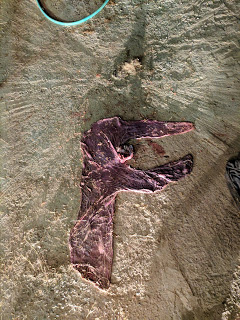Normally, we work on the ranch on Saturday mornings from 9 a.m. to 1 p.m. However, this time we had to go to the ranch earlier, due to Cheyenne showing signs of possibly having her baby. There are a few main signs that let us know a horse is nearing its due date. Some minor ones are restlessness, nipping at the flank, and lots of tail flicking. A few major signs are when their teats get waxed over, or if milk is actually dripping from their udder. The latter of the two usually means the baby is due in the next 24 to 48 hours. Cheyenne started experiencing all of these signs Friday during the day. This is fine because the ranch owner, Mr. Ames, is there to keep an eye on the horse. However, someone else needs to watch over the horse between 9 p.m. and 4 a.m. That's where the interns come in. We split up the six hours into shifts for each of us. If we take the latter of the two shifts we spend the night at Mr. Ames house. During the first night, I was scheduled for the 1 a.m. to 4 a.m. shift! Vijeeth had the shift before me, and since it was too late for him to go back home he stayed up with me. Each of the stables is outfitted with a camera. We can watch the camera from inside the house on a laptop, saving us the trouble of having to sit outside in the chilly night air. The main signs we are looking for are if the mare either lays down or her water breaks. Mares usually lay down to give birth, because it widens their birth canal, and thus makes it easier for the foal to come out. However, some first-time mares do not know this, so they may even deliver their baby standing up!
Unfortunately, Cheyenne did not give birth the next night. It was Saturday and that meant ranch duty. Our tasks for the day consisted of cleaning the stalls, spraying weeds and washing the horses. Mr. Ames crafted a pesticide cocktail and put it in a huge tank on the back of a John Deere tractor. Vijeeth and I would take turns driving the tractor, while the other person followed behind spraying any weeds. Cleaning the horses is a three step process. First, we brush them down to remove any loose dirt and hair. Next, we rinse them down. Finally, we lather them up using regular Pantene shampoo and rinse them off. During the process, we make sure to clean their tail and their mane. Lastly, we clean out the underside of their hooves. It is important to remember, when placing a horse's hoof down, make sure your feet are clear of the landing site. I had to learn this lesson the hard way.
Since Cheyenne had yet to give birth that meant we had to come back later that night for horse watch. Once again I was scheduled to do the 1 a.m. to 4 a.m. shift. Luckily, Cheyenne had her baby at around 9:30 p.m. that night. Unfortunately for me, that meant I missed out on seeing the colt being born.
A few interesting facts about foals:
- When a foal is born its legs are already almost as long as they will be when it has fully matured. This is why they look so awkward on their feet at first. It takes some time for them to get used to walking around on their long legs.
- Almost all foals are born with an extra long patch of chin hair (a horse goatee basically) regardless of their gender. Usually, the owner cuts the hair off so it doesn't get too messy, or they can let the hair fall out over time as the foal rubs it on different objects.
 |
Cheyenne's shampoo of choice
|
 |
| Lansdowne, Cheyenne's new friend, and stablemate. |
Cheyenne and her colt






















